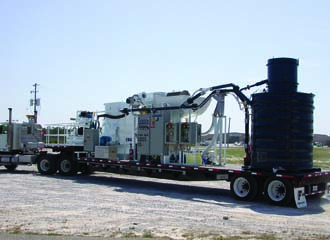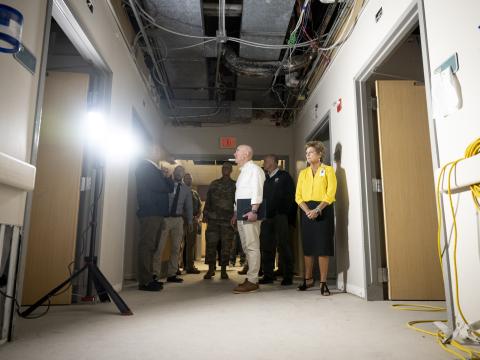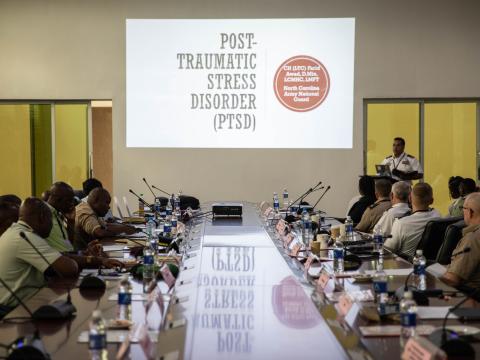Air Force Establishes Alternative Energy Firsts
The transportable plasma waste-to-energy system in place at Hurlburt Field, Florida, has proven the effectiveness of the gasification concept for eliminating municipal waste. Airmen are conducting additional tests with the system, which could offer solutions for military and civilian waste management.
The service is proving concepts and eliminating unusable ideas in nontraditional power. 
The entire U.S. Defense Department has put a strong emphasis in recent years on the need to develop alternative energy technologies not only to reduce dependence on foreign oil, but also to ensure its own energy security. Airmen have responsibility for more than 100 of these projects, and even personnel typically associated with the most dangerous missions have embarked on research. Special operations troops are determined to remain on the cutting edge as their headquarters base leads the way in confirming the viability of some new offerings.
Hurlburt Field, Florida, is home to the Air Force Special Operations Command (AFSOC), which has instituted an array of experiments designed to discover innovative means of producing power and reducing the energy pulled from the traditional electricity grid. Its most ground-breaking technology is a proof-of-concept study of the use of large-scale gasification to eliminate municipal solid waste. In the transportable plasma waste-to-energy system—which officials emphasize may be moveable but is not meant to be mobile—waste is broken down, reducing trash volume while filtering metals that can be recycled and dropping them to the bottom of the container. Heavier compounds fall out in a kind of slag.
During operation, synthesis gas releases from the tail pipe of the system. The Air Force cleans the gas and uses it to power the included generator. Lt. Col. David Novy, USAF, commander, 1st Special Operations Civil Engineer Squadron, explains that one of the concepts under evaluation is whether or not the system can become energy neutral. Currently, it does not produce enough power to operate independently of the electricity grid, but it has reduced its draw. Additional power augments also have been identified, but because of proprietary issues, they are not yet publicly releasable.
Another area of exploration involves disposing of hospital or hazardous waste in the system. Eliminating those materials carries a higher cost than municipal solid waste and also raises environmental and public health concerns. Officials must determine safe ways to process those products before they are destroyed via the system.
Regardless of future endeavors, officials involved in the research and development effort already have achieved positive results. “It does prove that gasification works,” Col. Novy states. Personnel were experimenting to find out if the process could be successful, save costs and reduce waste amounts. Col. Novy explains that simply decreasing the volume of trash in terms of the amount of material hauled cuts the energy expended by the Air Force.
According to the lieutenant colonel, the system can handle up to 10 tons of waste per day, though on a heavy day at Hurlburt, only 4 tons are produced. Personnel are looking to possibly partner with nearby Eglin Air Force Base, once the system becomes fully operational, to destroy that base’s trash as well.
Lt. Col. James. K. Kossler, USAF, chief, Asset Management and Operations Division at Headquarters AFSOC, explains that the size of the system is part of what makes it revolutionary. “When you scale things up, there’s different engineering,” he explains. The only other example of the system resides in Canada and handles 2 tons of waste per day. PyroGenesis Canada Incorporated operates that one and is helping with the Air Force’s plasma system effort. Col. Kossler says that even at 10 tons per day, the tool could not accommodate the demands of a major city. The Air Force looks to industry both to take the steps in that direction and to pursue industrial processes after receiving the results of other studies.
Col. Kossler emphasizes that the project is a research and development effort, the purpose of which is to take contaminants out of any synthetic gas produced. “Could we theoretically take this into Afghanistan?” he asks. “A lot has to happen first.” But the system could help warfighters avoid in-theater burn pits in the future. Though the technology is not deployable in its current state, the studies underway could result in field-ready benefits eventually. However, Col. Kossler explains, the military is not driving the industry, and the armed forces do not train military personnel to operate this type of technology. The experiments are restricted to studying feasibility, energy neutrality and reduced toxic output.
In addition to the plasma waste-to-energy undertaking, AFSOC and Hurlburt personnel recently undertook a variety of other alternative energy experiments. Through an effort totally distinct from the plasma system and dubbed Project Renewable Energy Demonstration (RED), officials worked to identify potential renewable energy opportunities.
According to Dr. Kevin T. Geiss, the deputy assistant secretary of the Air Force for energy, Office of the Assistant Secretary of the Air Force for Installations, Environment and Logistics, “The efforts at Hurlburt reduce demand for utility power and increase supply through on-site alternative energy generation. [They] demonstrate a cutting-edge technology that reduces the Air Force’s environmental impact and enhances energy security.”
The Air Force energy program has three pillars: reduce demand, increase supply and change the culture to make energy a consideration in all actions. Alternative energy is a key part of the second pillar. “Energy security ensures the Air Force has assured access to reliable supplies of energy when and where we need it in support of the mission,” Geiss says. “By generating renewable energy at installations, the Air Force is enhancing energy security by assuring supplies and becoming less dependent on traditional energy sources.” On-site generation capable of providing mission-essential energy requirements reduces the Air Force’s vulnerability to utility grid disruptions. In the case of the Hurlburt Field waste-to-energy project, the Air Force could reduce dependence on fossil fuel while improving its environmental footprint, he adds.
U.S. Air Force Renewable Energy Efforts The Air Force has 131 operational renewable energy projects at 56 installations generating 37 megawatts of power. Another 50 projects are awarded or under construction, which will bring the total number of installations to 77 and generation to 56 megawatts. Examples include:
“We must have assured access to reliable supplies of energy and the ability to protect and deliver sufficient fuel to meet operational needs,” Geiss explains. “Simply put, in order to accomplish our mission to fly, fight and win in air, space and cyberspace, we must have energy security.”
• Ellsworth Air Force Base (AFB), South Dakota: A 35-kilowatt photovoltaic project completed in 2011 will save about $3,900 per year in energy costs.
• F.E. Warren AFB, Wyoming: Three wind turbines generate 3.3 megawatts of power, roughly 10 percent of the base’s electricity.
• Hill AFB, Utah: Saves $400,000 on energy costs through the first landfill gas-to-energy project in the state. The landfill’s gas generator produced 15.1 million kilowatt hours in 2010, which represents nearly seven percent of the base’s total electrical usage.
• Massachusetts Military Reservation (MMR), Massachusetts: Employs three 1.5-megawatt wind turbines with plans to add an 8-megawatt photovoltaic system on the MMR’s 60-acre capped landfill.
• Nellis AFB, Nevada: One of the largest photovoltaic arrays in North America at 140 acres includes 72,000 solar panels and produces 14 megawatts of energy.
• Joint Base Pearl Harbor–Hickam, Hawaii: A solar array powers hydrogen production for a fueling station for hydrogen vehicles.
• Los Angeles AFB, California: Two photovoltaic systems produce 400 kilowatts of power with an additional 12 systems planned. The base also will become the first government facility to have 100 percent of its general-purpose vehicle fleet become all electric.
One of the Project RED initiatives studied algae as a source of biofuel. Researchers tried to determine the usefulness of certain strains of algae in an open-air design. Unfortunately, the environment in Florida’s panhandle interfered, and native strains took over. Despite the inability to produce biofuel in the effort, officials still mark the experiment as a type of success because they identified ineffective parameters. By eliminating the methods that fail, scientists come closer to finding the viable solution.
Had the algae produced fuel, personnel may have combined it with the plasma waste system. Col. Kossler explains that there was an idea to take carbon dioxide from the generator and use it to help the algae grow. But, “it never got to that point,” he states.
Other studies under Project RED looked at wind spires, electric vehicles and solar panels. In the photovoltaic arena alone, the project encompassed five different configurations including a cylinder design, a version printed off on a large sheet and one that tracked the sun during the day. Though Project RED ended last year, AFSOC still is evaluating results and data to understand what works best in particular environments and how the technologies could be shared across the Gulf Coast region and potentially applied to other bases. Col. Kossler says the command only had enough money to analyze solutions for four months, and researchers want a full year of study before reaching conclusions.
Also underway on Hurlburt is an initiative to create a net-zero facility. Personnel have constructed a small building that uses photovoltaic cells to power its environmental systems and lights. In addition, the site collects thousands of gallons of rain water for use in the irrigation of the grounds. Because more people than expected have used the facility, it still pulls energy, but at a much reduced rate than a traditional building. And, when the facility is not in use, it actually can replace power on the grid.
Moving forward, AFSOC will look for more ways to improve energy efficiency. Some are basic, but the savings they offer add to the total sum of reduced dependence. For example, AFSOC is installing meters to establish energy-use benchmarks on various facilities. In theory, all dormitories would have the same power draw per person. If, through the meters, a dorm building is identified as drawing more power than its counterparts, officials can try to identify and resolve the problem.
Another effort looks at heating, ventilation and air conditioning, or HVAC, systems to ensure they run at their most efficient capacities. “It doesn’t have the splash, but it does have some good results,” Col. Kossler says. Other simple measures include light monitors in halls and bathrooms that turn off bulbs when areas are not in use. Col. Novy says that such features are neither fancy nor new, but they take time and effort to install.
AFSOC also encourages its installations to undertake projects that could result in net-zero or minor-footprint energy draws and emphasizes Leadership in Energy and Environmental Design (LEED)-certifiable construction. Col. Novy shares that a recently finished headquarters building at Hurlburt incorporates LEED features including a low-profile cantilever system over windows to reflect light inside during the day. This strategy reduces the need for artificial lights.
The various technologies evaluated or under evaluation at Hurlburt all are of interest to the larger Air Force. As they prove reliable and cost competitive, they likely will make their way to other installations. Geiss says, “In fact, the Air Force’s Real Property Agency is exploring the use of enhanced-use leases to make under-utilized areas on bases available to the private sector for use as part of utility scale waste-to-energy plants, which could be based on similar technologies.” Over time, these projects and others will ensure the Air Force is able to continue operations, he adds.
WEB RESOURCES
Air Force Special Operations Command: www.afsoc.af.mil
Air Force Installations, Environment and Logistics: www.safie.hq.af.mil/esoh
Air Force Real Property Agency: www.safie.hq.af.mil/afrpa/index.asp



